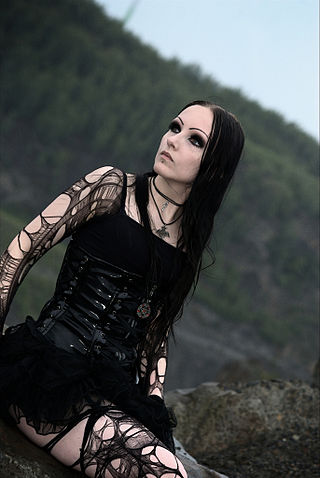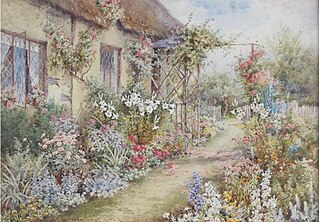
Goth is a music-based subculture that began in the United Kingdom during the early 1980s. It was developed by fans of gothic rock, an offshoot of the post-punk music genre. Post-punk artists who presaged the gothic rock genre and helped develop and shape the subculture include Siouxsie and the Banshees, Bauhaus, the Cure, and Joy Division.

Gothic fashion is a clothing style worn by members of the goth subculture. A dark, sometimes morbid, fashion and style of dress, typical gothic fashion includes black dyed hair and black clothes. Both male and female goths can wear dark eyeliner, dark nail polish and lipstick, and dramatic makeup. Styles are often borrowed from the Elizabethans and Victorians. BDSM imagery and paraphenalia are also common. Gothic fashion is sometimes confused with heavy metal fashion and emo fashion.

Lolita fashion is a subculture from Japan that is highly influenced by Victorian clothing and styles from the Rococo period. A very distinctive property of Lolita fashion is the aesthetic of cuteness. This clothing subculture can be categorized into three main substyles: 'Gothic', 'Classic', and 'Sweet'. Many other substyles such as 'Sailor', 'Country', 'Hime' (princess), 'Guro' (grotesque), 'Qi' and 'Wa', 'Punk', 'Shiro' (white), 'Kuro' (black), and 'Steampunk' Lolita also exist. This style evolved into a widely followed subculture in Japan and other countries in the 1990s and 2000s and may have waned in Japan as of the 2010s as the fashion became more mainstream.

Arc'teryx is a Canadian high-end design company specializing in outdoor apparel and equipment headquartered in North Vancouver, British Columbia. It focuses on technical apparel for mountaineering and Alpine sports, including related accessories. The company's name and logo reference the Archaeopteryx, the transitional fossil of early dinosaurs to modern dinosaurs (birds). Arc'teryx is known for its waterproof Gore-Tex shell jackets, knitwear, and down parkas.

Dark culture, also called dark alternative scene, includes goth and dark wave culture, the dark neoclassical/dark ambient scene, parts of the post-industrial scene parts of neofolk and the early gothic metal scene. Dark culture's origin lies in followers of dark wave and independent music, but over the decades it has developed to a social network held together by a common concept of aesthetics, self-representation, and individualism. The musical preferences of the dark scene are characterized by a mix of styles ranging from futurism, electropop, early music, (neo-) classical, and folk music to punk rock, rock, techno and ambient music.
Alternative fashion or alt fashion is fashion that stands apart from mainstream, commercial fashion. It includes both styles which do not conform to the mainstream fashion of their time and the styles of specific subcultures. Some alternative fashion styles are attention-grabbing and more artistic than practical, while some develop from anti-fashion sentiments that focus on simplicity and utilitarianism.

Soft grunge was a fashion trend that originated on Tumblr around the late 2000s and early 2010s. Beginning as an outgrowth of the 2000s indie sleaze fashion trend but with a greater influence from the 1990s, particularly grunge fashion, the style began as a reaction against the glamor fitness culture which was dominant in popular culture at the time. It is characterized by its merger of cute and aggressive fashion hallmarks like chokers, tennis skirts, leather jackets and boots, flower crowns, distressed denim and pastel colors. Soft grunge reached its peak popularity around 2014, by which time it had been embraced by high fashion designers including Hedi Slimane and Jeremy Scott and been worn by celebrities including Charli XCX. Its internet-based merger of subculture, fashion and music made it one of the earliest examples of an internet aesthetic. In the early 2020s, the style experienced a minor resurgence due to videos posted on the video sharing application TikTok.

TikTok, whose mainland Chinese counterpart is Douyin, is a short-form video hosting service owned by Chinese internet company ByteDance. It hosts user-submitted videos, which can range in duration from three seconds to 10 minutes. It can be accessed with a smart phone app.

E-girls and e-boys, sometimes collectively known as e-kids, are a youth subculture of Gen Z that emerged in the late 2010s, notably popularized by the video-sharing application TikTok. It is an evolution of emo, scene and mall goth fashion combined with Japanese and Korean street fashion.

Cottagecore is an internet aesthetic idealising rural life. Originally based on a rural European life, it was developed throughout the 2010s and was first named cottagecore on Tumblr in 2018. The aesthetic centres on traditional rural clothing, interior design, and crafts such as drawing, baking, and pottery, and is related to similar aesthetic movements such as grandmacore, goblincore, gnomecore and fairycore.

The fashions of the 2020s represent a departure from 2010s fashion and feature a nostalgia for older aesthetics. They have been largely inspired by styles of the late 1990s to mid-2000s, 1980s, and late 1960s to early 1970s Early in the decade, several publications noted the shortened trend and nostalgia cycle in 2020s fashion. Fashion was also shaped by the COVID-19 pandemic, which had a major impact on the fashion industry, and led to shifting retail and consumer trends.

Mall goths are a subculture that began in the late-1990s in the United States. Originating as a pejorative to describe people who dressed goth for the fashion rather than culture, it eventually developed its own culture based around nu metal, industrial metal, emo and the Hot Topic store chain. It has variously been described as a part of the goth subculture, as well as a separate subculture simply influenced by goth.

Goblincore is an internet aesthetic and subculture inspired by the folklore of goblins, centered on the celebration of natural ecosystems usually considered less beautiful by conventional norms, such as soil, animals, and second-hand objects.

Indie sleaze was a fashion style popular in the United States and United Kingdom from approximately 2006 to 2012. Characterised by an affordable, messy and lethargic take on vintage fashion styles, especially the 1970s, the style was particularly popular amongst the hipster subculture and indie rock bands.
Soft Girl or Softie describes a youth subculture that emerged among female teenagers around mid-to late-2019. Soft girl is a fashion style and a lifestyle, popular among some young women on social media, based on a deliberately cutesy, feminine look with a "girly girl" attitude. Being a soft girl also may involve a tender, sweet, and sensitive personality.
An Internet aesthetic, also simply referred to as an aesthetic or microaesthetic, is a visual art style, sometimes accompanied by a fashion style, subculture, or music genre, that usually originates from the Internet or is popularized on it. Throughout the 2010s and 2020s, online aesthetics gained increasing popularity, specifically on social media platforms such as Tumblr, Pinterest, Instagram, and TikTok, and often were used by people to express their individuality and creativity. They can also be used to create a sense of community and belonging among people who share the same interests. The term aesthetic has been described as being "totally divorced from its academic origins", and is commonly used as an adjective.
Corecore is an Internet aesthetic and artistic movement aiming to capture post-2020 sensibilities. A product of youth culture in the 2020s, the corecore aesthetic can largely be found on TikTok, where it juxtaposes various video clips while emotional music plays.
The online video platform TikTok has had worldwide a social, political, and cultural impact since its global launch in September 2017. The platform has rapidly grown its userbase since its launch and surpassed 2 billion downloads in October 2020. It became the world's most popular website, ahead of Google, for the year 2021.
Light academia is an internet aesthetic and subculture, that emphasizes visually light aesthetics and positive themes, including optimism, joy, and friendship. Accordingly, light academia is often considered to be the visually and emotionally lighter counterpart to dark academia. The term light academia was coined on Tumblr in 2019 and gained popularity during the early 2020s.

Coquette aesthetic is a 2020s fashion trend that is characterized by a mix of sweet, romantic, and sometimes playful elements and focuses on femininity through the use of clothes with lace, flounces, pastel colors, and bows, often draws inspiration from historical periods like the Victorian era and the 1950s, with a modern twist.

















